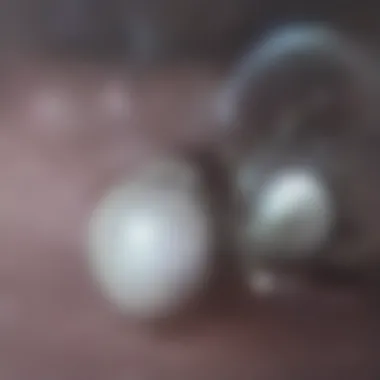Understanding Penile Stimulation Nerves and Their Impact


Intro
The human body is a complex system, capable of extraordinary functions and sensations. Among these intricate systems, the penile stimulation nerves play a crucial role in sexual health and function. Understanding these nerves not only enhances knowledge about human anatomy but also provides insights into various therapeutic approaches to address sexual dysfunction.
In this exploration, we will delve into the anatomical and physiological dynamics of penile stimulation nerves, the psychological factors at play, and how this knowledge can bridge the gap between basic science and real-world applications.
Key Findings
- The primary nerves responsible for penile stimulation are the dorsal nerve of the penis and the cavernosal nerves. These nerves emerge from the pudendal nerve and are essential for both sensory and erectile functions.
- Stimulation of these nerves can promote erectile function through increased blood flow and physiological responses.
- There is a significant interplay between psychological factors and nerve function, which can influence sexual performance and satisfaction.
Summary of the main results
Research suggests that understanding the anatomy of penile nerve endings is key to both physical and psychological aspects of sexual health. The dorsal nerve mostly carries sensory input while the cavernosal nerves are primarily involved in initiating erections. This effective communication between nerve pathways establishes the foundation for sexual arousal and pleasure.
Significance of findings within the scientific community
These findings are crucial as they highlight the multi-faceted nature of sexual health, emphasizing the need for integrative approaches in therapy. More studies are needed to explore how these nerves respond to different stimuli and therapies. The scientific community recognizes this intersection of anatomy and psychology as vital for developing more effective interventions for sexual dysfunction.
Implications of the Research
The exploration of penile stimulation nerves has far-reaching implications beyond mere academic interest.
- Applications of findings in real-world scenarios
- Potential impact on future research directions
The insights derived from studying penile nerve stimulation can inform future research on various sexual dysfunctions, such as premature ejaculation and libido changes. Additionally, with the rise of telemedicine and digital health solutions, there is an opportunity for more extensive data collection regarding individual responses to nerve stimulation therapies, which may pave the way for personalized treatment plans.
- Improved understanding of these nerves can lead to better treatment options for erectile dysfunction, potentially drawing from neuromodulation techniques.
- Sexual health therapies can integrate psychological support by acknowledging the importance of mental well-being in sexual function.
Understanding the role of penile stimulation nerves not only deepens our comprehension of human biology but also equips us with knowledge that could enhance the quality of many individuals’ lives.
Prelude to Penile Stimulation Nerves
Understanding penile stimulation nerves is critical for grasping the complexities surrounding male sexual health. These nerves play a vital role in various physiological processes, including sexual arousal and erectile function. A detailed understanding of this topic can lead to significant benefits in both medical practice and personal well-being.
Defining Penile Stimulation
Penile stimulation refers to the sensory and physiological responses that occur when the nerves of the penis are activated. This activation can be triggered by physical touch, psychological stimuli, or a combination of both. The nerve network includes both the peripheral and central nervous systems, and each component contributes to the overall sensation experienced during sexual arousal.
There are two primary aspects to consider when defining penile stimulation:
- Sensory Input: This involves how signals are sent from nerve endings in the penis to the brain, where they are interpreted as pleasurable sensations.
- Erectile Response: This is the physiological reaction of the penis becoming engorged with blood, leading to erection. Understanding how these elements work together helps in comprehending male sexual function better.
Importance of Understanding Nerve Functions
Grasping how penile stimulation nerves function is essential for several reasons:
- Medical Insights: Knowledge of nerve functions aids in diagnosing conditions like erectile dysfunction. Understanding the pathways taken by nerve signals can help identify where problems may occur.
- Treatment Approaches: Awareness of the underlying mechanisms can inform treatment options. Treatments ranging from medication to physical therapy can target specific aspects of nerve function.
- Psychological Impact: Mental health plays a significant role in sexual performance. By understanding the relationship between psychological processes and nerve responses, we can develop better approaches to treat issues like sexual anxiety.
- Enhancing Sexual Health: By learning about the nervous system's involvement in sexual arousal, individuals can make more informed choices about their sexual health and well-being.
"Nerve function is not just a physiological aspect; it encompasses psychological dimensions that can heavily influence male sexual experiences."


Understanding these nerves strengthens the connection between scientific research and real-world implications, making it an indispensable area of study in both sexology and general health.
Anatomy of the Penile Nerves
Understanding the anatomy of the penile nerves is crucial in appreciating the overall functionality related to sexual health. The structure and layout of these nerves contribute significantly to sensations and erections. Recognizing this anatomy not only aids in comprehending common issues related to erectile dysfunction but also illustrates the complex interplay of various bodily systems involved in sexual arousal.
Overview of the Nervous System
The nervous system is the body's communication network. It encompasses the brain, spinal cord, and all peripheral nerves. In the context of penile stimulation, the peripheral nervous system plays a significant role. This system includes autonomic nerves, which regulate involuntary functions and sensory nerves that convey feelings and sensations. Understanding how these systems work together can provide insight into the full experience of erectile function. The interaction between these components determines how sensory information is processed and transmitted to the brain, affecting sexual arousal.
Major Nerves Contributing to Penile Sensation
There are specific nerves that significantly impact penile sensation. The most prominent of these are the cavernous nerves and the dorsal nerve of the penis.
- Cavernous Nerves: These are critical for achieving and maintaining an erection. They originate from the pelvic plexus and travel along the sides of the penis. When stimulated, they help increase blood flow into the erectile tissues.
- Dorsal Nerve: This nerve provides sensory innervation to the head and shaft of the penis. It is essential for the experience of sexual pleasure and the function of erectile tissues.
Their functioning is interconnected. When one is compromised, it may affect the action of the other. Understanding these nerves can lead to better therapeutic strategies for erectile dysfunction.
Peripheral vs. Central Nervous System
The distinction between the peripheral and central nervous systems is significant when discussing penile stimulation. The peripheral nervous system includes all nerves outside the brain and spinal cord. It is responsible for relaying information between the body and the brain. The central nervous system, meanwhile, comprises the brain and spinal cord. It is where sensory information is processed and decisions for responses are made.
In sexual health, the peripheral system plays a direct role in signal transmission to the brain about arousal and sensation. Conversely, the central nervous system interprets this information and triggers physiological responses.
Understanding the relationship between these nervous systems is key to addressing sexual dysfunctions effectively.
Physiological Mechanisms of Penile Stimulation
The physiological mechanisms of penile stimulation are crucial to understanding sexual function. These mechanisms involve a complex interplay of sensory pathways, neurotransmitters, and biological responses that shape arousal and erectile function. By examining these elements, we gain insight into both normal function and dysfunction. This knowledge is essential for effectively addressing sexual health issues and improving therapeutic approaches.
Sensory Pathways for Sexual Arousal
Sensory pathways for sexual arousal begin with stimulation of the penis. These pathways are primarily mediated by the dorsal nerve of the penis, which is a branch of the pudendal nerve. Stimulation triggers various sensory receptors, sending signals to the spinal cord and brain.
The process includes:
- Tactile Stimuli: Physical stimulation experienced through touch.
- Temperature and Pain Receptors: These receptors also play a minor role.
Once sensory signals reach the brain, they are processed in areas associated with sexual arousal, leading to increased blood flow and psychological stimulation.
Neurotransmitters and Hormonal Influences
Neurotransmitters and hormones play a significant role in penile stimulation. Several key substances contribute to the physiological processes:
- Nitric Oxide (NO): This neurotransmitter is vital for initiating the erectile process by relaxing smooth muscles in the blood vessels.
- Dopamine: This neurotransmitter is associated with pleasure and reward, enhancing arousal.
- Testosterone: This hormone significantly influences libido and sexual desire.
Alterations in levels of these substances can affect sexual response and arousal, thereby impacting overall sexual health.
Erectile Response and Nerve Interactions


The erectile response is a finely tuned physiological reaction involving multiple nerve pathways and vascular dynamics. When stimulated, nerves release nitric oxide, leading to the dilation of blood vessels in the penis. This process enhances blood flow, causing tumescence and rigidity of the erectile tissues.
Key aspects include:
- Nerve Activation: Proper nerve function is essential for triggering an adequate erection.
- Feedback Mechanisms: The body has feedback loops that ensure the erectile response can be maintained or retracted as needed.
"The collaboration of nerves and blood flow is fundamental for achieving and sustaining an erection."
Understanding these mechanisms is critical, as they highlight potential areas of dysfunction in individuals experiencing erectile difficulties. Moreover, insights from this field of study inform targeted therapies, enhancing patient outcomes.
Psychological Aspects of Penile Stimulation
Understanding the psychological aspects of penile stimulation is crucial to grasp the entirety of sexual health and function. Mental states can significantly influence physiological responses, including arousal and enjoyment. The interplay between mind and body is complex, and recognizing the psychological factors can aid in both understanding and addressing sexual dysfunction.
Role of Psychological Stimuli in Sexual Response
Psychological stimuli encompass various mental and emotional triggers that can initiate or enhance sexual arousal. These stimuli may include visual cues, fantasies, or relational dynamics with a partner. The brain acts as a powerful component in this process, interpreting sensory information and creating an emotional response. Some key elements include:
- Visual Imagery: Images or thoughts that an individual finds appealing can evoke intense arousal.
- Emotional Connection: A strong emotional bond with a partner often enhances sexual responses, signaling to the body to prepare for arousal.
- Fantasies: Engaging in sexual fantasies can stimulate the mind in ways that translate to physical arousal.
Moreover, individual differences play a significant role. What arouses one person may not have the same effect on another. This variability highlights the importance of personal context in sexual experience. Understanding these psychological nuances can foster better communication between partners, ultimately enhancing satisfaction.
Impact of Stress and Anxiety on Nerve Function
Stress and anxiety can have debilitating effects on sexual function. When a person is overwhelmed by stress, the body's physiological state can shift. This shift directly affects nerve function related to stimulation and arousal. Key points to consider include:
- Hormonal Changes: Stress triggers the release of hormones like cortisol, which can inhibit the production of testosterone, an essential hormone in sexual health.
- Nervous System Response: Anxiety can heighten the sympathetic nervous system's activity, leading to a fight-or-flight response. This response is counterproductive to sexual arousal, making it more challenging to achieve or maintain an erection.
- Decreased Blood Flow: Psychological stress impacts blood circulation, crucial for erectile function. Reduced blood flow limits the ability to achieve a satisfactory erection.
"The mind is a powerful force; stress can cripple the body's response to stimulation."
Clinical Implications of Penile Nerve Dysfunction
Understanding the clinical implications of penile nerve dysfunction is crucial for diagnosing and treating related health issues. Penile nerve dysfunction can have significant consequences on sexual health, affecting both psychological well-being and physical intimacy. Awareness of these implications helps in the development of tailored approaches for patients, addressing not only the physiological aspects but also the emotional and relational dimensions of sexual dysfunction.
Diagnosing Nerve-Related Conditions
Diagnosing nerve-related conditions often involves a combination of patient history, physical examinations, and specific diagnostic tests. Healthcare professionals commonly focus on the following:
- Patient History: Gathering detailed information about symptoms, onset, and duration is essential. Questions regarding lifestyle, medical history, and medications can provide valuable insights.
- Physical Examination: A thorough examination may include assessments of blood flow, nerve sensitivity, and the overall health of the penis.
- Neurological Tests: Electromyography and nerve conduction studies help determine whether nerves are functioning correctly and identify any damage.
Each of these methods plays a role in forming a comprehensive picture of the patient's condition, allowing for accurate diagnosis and appropriate treatment planning.
Treatments for Erectile Dysfunction
Erectile dysfunction as a result of penile nerve dysfunction can be complex, necessitating varied treatment strategies. Common approaches include:
- Phosphodiesterase Type 5 Inhibitors: Medications such as Sildenafil (Viagra) and Tadalafil (Cialis) enhance blood flow to the penis, aiding in achieving an erection.
- Hormonal Therapy: Assessing testosterone levels and supplementing hormones if deficiencies are present can significantly improve erectile function.
- Vacuum Erection Devices: These devices create a vacuum to increase blood flow, followed by the placement of a constriction band to maintain an erection.
- Penile Injections: Intracavernosal injections of medications like Alprostadil can directly induce an erection by enhancing blood flow to the penis.
Each treatment has benefits and limitations that should be thoroughly explored with the patient, ensuring an informed decision is made.


Innovative Therapies Targeting Nerve Stimulation
Recent developments have led to innovative therapies that target nerve stimulation for treating erectile dysfunction. These approaches are at the forefront of research and include:
- Neuromodulation Techniques: Methods like sacral nerve stimulation involve implanting a device to regulate nerve activity, potentially improving erectile function.
- Bioelectrical Stimulation: This technique uses electrical impulses to stimulate nerves and improve functionality, offering a non-invasive treatment option.
- Gene Therapy: Experimental studies investigate the introduction of specific genes into penile tissues to promote nerve repair and regeneration.
Overall, advancements in these areas exemplify the ongoing evolution in understanding and treating penile nerve dysfunction. Each therapeutic option not only aims to restore sexual function but also to enhance the quality of life for individuals affected by these conditions.
The recognition of these conditions and their implications indicates a growing emphasis on the importance of addressing sexual health as a key component of overall well-being. As research in this field progresses, we can expect further optimistic developments that not only address the symptoms but also target the underlying nerve dysfunction.
The Future of Research on Penile Nerve Stimulation
Exploring the future of research on penile nerve stimulation is crucial in understanding sexual health and enhancing therapeutic outcomes. The significance lies in the evolution of methods that can redefine treatment options for various conditions. An emphasis on this area of research can lead to breakthroughs that enhance not only individual experiences but also contribute to broader societal understanding of sexual health.
Current research avenues indicate the necessity of advancing our understanding of erectile dysfunction and other related conditions. Insights gained from ongoing studies can lead to improved diagnosis and treatment, offering patients more effective solutions.
Emerging Technologies in Nerve Research
Recent advancements in technology open new doors for understanding penile nerve stimulation. Tools like high-resolution imaging and gene editing techniques allow researchers to explore the intricate workings of nerves at a more detailed level.
These technologies help identify how nerves interact with various stimuli, physically and psychologically. For instance, optogenetics enables scientists to manipulate nerve activity using light, offering insights on how specific nerves relate to sexual arousal and response.
Additionally, wearable technologies are becoming more prominent in sexual health research. These devices can gather data on physiological responses during intimacy. With such insights, researchers can analyze patterns that were previously difficult to observe. This growing data pool can lead to enhanced patient-specific treatments.
Interdisciplinary Approaches to Understanding Sexual Health
Understanding penile nerve stimulation requires a collaborative effort across various disciplines. Research teams that include urologists, psychologists, and neuroscientists can integrate their expertise to explore sexual health holistically.
Such interdisciplinary cooperation can lead to enriched perspectives. For example, combining insights from biology with psychological frameworks helps address how emotional states impact physiological responses.
Furthermore, public health researchers can play a vital role in studying the societal implications of sexual health. They can assess how access to medical care and educational resources affects sexual wellness.
"Interdisciplinary approaches not only strengthen research outcomes but also provide a deeper understanding of the various factors affecting sexual health."
The continuous collaboration and pooling of knowledge from multiple fields will enhance the understanding of penile nerve stimulation and ensure that future research translates effectively into practice.
Epilogue
Understanding the role of penile stimulation nerves is crucial for grasping how physical and psychological factors intertwine to influence sexual health. This article delves into the complexities of nerve functions, highlighting their importance in many aspects of human sexuality. The conclusions drawn are significant for both clinical practice and academic exploration.
Summarizing Key Points
The exploration of penile stimulation nerves reveals essential insights:
- Anatomical Knowledge: A clear understanding of the anatomy of the penile nerves contributes to recognizing how nerve pathways affect erectile function.
- Physiological Response: The intricate relationship between sensory pathways and neurotransmitters emphasizes how our body communicates during sexual arousal.
- Psychological Influences: Psychological conditions such as stress can significantly impact nerve function, which can lead to erectile dysfunction or reduced sexual pleasure.
- Clinical Implications: Identification of nerve-related conditions has strong implications for treatment strategies, enhancing approaches towards sexual health clinics.
- Future Research: The constant evolution of research will likely uncover new therapeutic options and treatment protocols.
Every point discussed underscores the importance of integrating anatomy, physiology, and psychology in understanding sexual health.
Encouraging Further Research and Discussion
Further investigation into penile nerve stimulation is vital. Many areas for exploration remain:
- Emerging Therapies: Innovations in medical technology can potentially improve nerve function. The development of nerve stimulation therapies may offer new paths to lessen erectile dysfunction.
- Inclusive Studies: More inclusive research taking into account diverse populations will yield richer, more applicable results.
- Interdisciplinary Approaches: Collaboration among psychologists, biologists, and medical professionals can provide a holistic understanding of sexual health.
In summary, the conclusion is not merely a wrap-up; it serves as a foundation for ongoing inquiry. By encouraging continued research and discussions, we can better address the multifaceted nature of penile stimulation nerves and contribute to the broader conversation surrounding sexual health.







